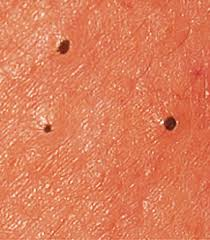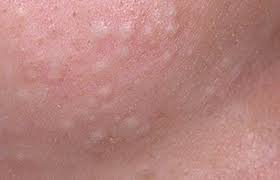Comedones
Comedones are small, flesh colored white or dark bumps (papules) frequently found on the forehead and chin of those with acne. They are found at the opening of a sebaceous follicle (pore). A single lesion is a comedo. Comedo is divided into two major categories, open comedo or blackhead and closed comedo or whitehead.
A closed comedo has an obstructed opening to
the skin and may rupture to cause a low-grade skin inflammatory reaction in the
area. The common name for a closed comedo is a whitehead.
An open comedo has a wide opening to the skin
and is capped with a blackened mass of skin debris. It is commonly known as a
blackhead.
Causes of comedones
Comedonal acne arise when cells lining the sebaceous duct proliferate (cornification), and increased sebum production. A comedo is formed by the debris blocking the sebaceous duct and hair follicle. It is now known that comedonal acne also involve inflammation.
Factors that causes the development of comedonal acne includes:
- Excessive activity of the male sex hormone within skin cells
- Over hydrated skin premenstrual, from moisturisers or in humid conditions
- Contact with certain chemicals including oily pomades and some dyes in cosmetics
- Rupture of the follicle by injury such as squeezing pimples, abrasive washing, chemical peels or laser treatments
- Smoking – comedonal acne is more common in smokers than in non-smokers
- Certain
dietary factors may contribute to comedonal acne, particularly milk products
and high glycaemic-index foods (sugars and fats).
Formation
Comedonal acne or other acne occurs when sebaceous glands of
the skin begin to secrete oil during puberty. These glands are stimulated by
male hormones that are produced in the adrenal glands. Under certain
circumstances, cells that are close to the openings of the sebaceous glands
block the openings. This causes a buildup of oil underneath the skin. Bacteria
then multiply, and cause the surrounding tissues to become inflamed after the
follicle ruptures. If the pore is wide
open, oil becomes oxidized and the oil
changes from white to black, and the result is a blackhead. This is how the two
types of comedonal acne develop.
Features
|
Follicles have a
wider opening and are filled with plugs of sebum and sloughed off cells which
appear black in colour |
 |
|
Closed (whiteheads) comedones - form obstruction of
the follicles with the same material but the opening is smaller |
 |
Prevention
The most effective way to prevent comedonal acne is to keep the skin clean and clear of debris that may clog the pores.
- Use gentle cleansers and exfoliators to remove the build-up of excess oil, dirt and dead skin cells. After cleansing, use an oil-free moisturizer to keep the skin adequately hydrated.
- Another way to prevent acne is to use cosmetics specially designed for acne prone skin that are either oil-free or non-comedogenic (which simply means they don’t clog pores).
- Avoid contact with objects that may be greasy.
- Avoid
touching your face after handling an item that is dirty or oily.
Treatment
Choose
"comedolytic" topical medications. These should be applied once or
twice daily as a thin smear to the entire area affected. It may take several
weeks to months before worthwhile improvement occurs. Treatment needs to be
continued long term (sometimes for many years). Consult with a dermatologist if
your acne doesn't respond to over-the-counter treatments.
Tags
papules, blackhead, whitehead, topical medications, over-the-counter treatments
Irresistible Acne Remedies. This free newsletter is delivered monthly, straight to your INBOX. It covers all new pages since the last issue. Sign up here...


New! Comments
Have your say about what you just read! Leave me a comment in the box below.